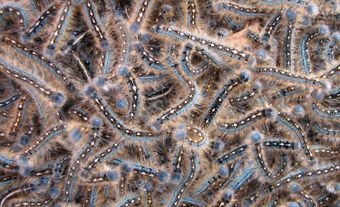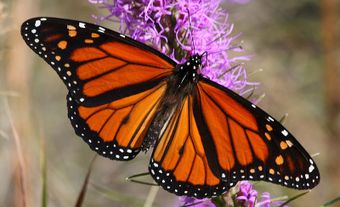Fireflies, also known as lightning bugs, are beetles belonging to the family Lampyridae and are best known for their ability to produce light. There are over 2,200 species of fireflies worldwide, including 32 species found in Canada, with more being discovered every year. Of these species, some of the most commonly encountered in Canada are the winter firefly (Ellychnia corrusca), the black firefly (Lucidota atra) and the common firefly (Photinus pyralis).

Description
Fireflies are relatively soft-bodied beetles that range from 5 mm to 25 mm in length. Compared to other beetles, adult fireflies have soft elytra, or forewings, which cover and protect the folded hindwings. They also possess a distinctively wide pronotum (the plate-like structure that covers the thorax), which acts as a protective cover for the head and gives the firefly an oval silhouette when at rest. Their light-producing organs are located on the end of their abdomen. Fireflies are typically black or brown and may have yellow, orange or red markings on their elytra and pronotum.
Fireflies exhibit sexual dimorphism, with males and females often differing in appearance. Many species have non-flying females that more closely resemble larvae, a phenomenon called female neoteny. The larvae themselves are elongated and grub-like, with six legs, prominent mandibles, and hardened plates along their back.
The round eggs, which can be white, yellow or orange depending on the species, may be laid singly or in clutches. Many firefly eggs are very faintly bioluminescent, although this can be difficult to detect with the naked eye. During the firefly’s pupal stage, it remains mostly motionless as it undergoes metamorphosis into an adult. The developing legs, eyes, antennae and wings are visible on the pupa, which may wiggle and light up its abdomen if it is disturbed.

Bioluminescence
The light organs of adult fireflies can produce yellow, green, or even pale red light. The light is produced when an enzyme called luciferase acts on the substrate luciferin in the presence of oxygen and an energy source.
For adult fireflies, the primary function of producing light is reproductive display, with males and females signalling to one another using flashes of light or a steady glow The light displays of different species vary widely in colour, duration, timing, flight pattern, and even synchronization. In some cases, males will come together in large numbers and time their flashes together, creating stunning displays as the waves of light pass through the gathered insects.
Although not all adult fireflies emit light, all known species of fireflies have bioluminescent larvae, commonly called glow-worms, which use their bioluminescence to signal to predators that they are distasteful.
Reproduction and Development
Many species of fireflies use bioluminescence for reproductive display, with males and females signalling to one another in order to find suitable mates of the same species. Other species are active in the daytime and instead use pheromones, or chemical cues, to locate potential mates; these species are sometimes known as day-active “dark” fireflies.
Like all beetles, fireflies undergo complete metamorphosis, going through the four stages of egg, larva, pupa and adult. This life cycle can take anywhere from a few months to three years, depending on the species and climate, with the majority of the insect’s life typically spent in the larval stage.
After mating, the female will lay her eggs in moist soil or vegetation. The larvae hatch several weeks later and feed until they are large enough to pupate, often underground or in rotting organic matter. Flighted adults spend most of their time in vegetation and can be found in grassy meadows or the canopies of trees. The majority of species emerge as adults in late spring or early summer, although some, such as the winter firefly (Ellychnia corrusca), overwinter as adults.

Distribution and Habitat
Fireflies are found on every continent except Antarctica, in both temperate and tropical climates. In Canada, they are found in all provinces, as well as the Yukon, with the conspicuous, light-displaying species particularly common in Eastern Canada. In Western Canada, day-active “dark” fireflies are more abundant.
Fireflies can live in various habitats, provided there is sufficient moisture. They can often be found in wetlands, meadows, forests, and even urban areas when suitable habitat is available. Eggs, larvae, pupae and flightless females are commonly found in moss, damp soil, leaf litter, or rotting organic matter.
Diet and Predators
Larval fireflies are predators, hunting invertebrates such as snails, slugs, earthworms and other insect larvae. They are active predators, using neurotoxins injected through their mandibles to immobilize their prey.
Some adult fireflies do not eat at all, while others feed on nectar and pollen. Notably, the females of several North American species in the genus Photuris hunt other adult fireflies. They do this by using dishonest signalling to fake the bioluminescent patterns of the female firefly of a different species and then eat the males that approach in the hope of finding a mate.
Fireflies are distasteful to most vertebrate predators due to containing lucibufagin compounds. However, they do appear to be eaten by invertebrates, such as spiders and assassin bugs.
Cultural Significance
Various cultures have placed significance on fireflies and their light displays. They are commonly featured in art, literature and cultural traditions. Various Indigenous cultures in Canada, including the Anishinaabe, have several stories and traditions which reference fireflies. Fireflies have additionally been influential in biomedical research, with luciferase, the light-emitting compound produced by fireflies, serving as a valuable tool in studies of various diseases, including HIV and cancer.
Ecological Importance
Fireflies play important ecological roles in their ecosystems. They are often significant predators of invertebrates such as snails and slugs and additionally serve as prey to various invertebrate predators. Fireflies are also sometimes used as an indicator species, as their presence or absence is conspicuous and can reflect changes in habitat quality and pollution levels.
Conservation
Firefly populations are declining worldwide. As of 2021, the IUCN Red List has assessed over 128 species of North American fireflies and identified 14 as being threatened with extinction. Threats to fireflies include habitat loss and fragmentation, pesticide use and light pollution, which can interfere with their mating displays. Leaf litter is an important habitat feature for fireflies, as it provides a place for them to overwinter and lay their eggs. The removal of these features from yards and greenspaces reduces firefly habitat.
Fireflies are beloved by many people and are seen as a flagship species. Their beauty and popularity help spread awareness about the issues threatening firefly habitats and have also been used to help with conservation efforts such as habitat restoration, protection and stewardship.

 Share on Facebook
Share on Facebook Share on X
Share on X Share by Email
Share by Email Share on Google Classroom
Share on Google Classroom




